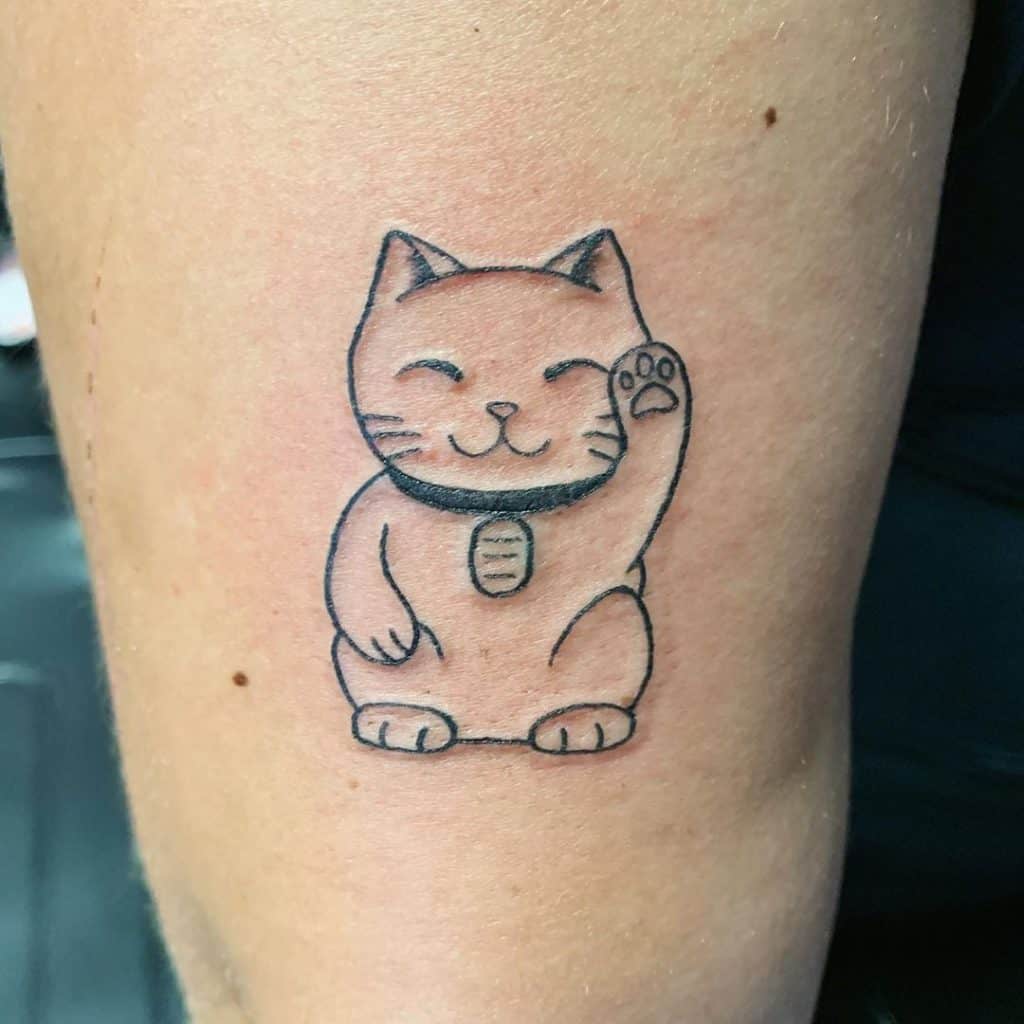
Ghim trên mèo
The Maneki Neko is a Japanese figurine representing a sitting cat with one of its front paws raised as a sign of welcome. This small and "welcoming" cat has, according to its color, a different meaning, but it is especially known to bring happiness, luck and good fortune to its owner. Very much appreciated in Japanese folklore, this figurine.

Maneki Neko Tattoos Explained Origins, Meanings & Symbols
Signification des Tatouages Japonais : Le Chat Maneki Neko. Le Maneki Neko est le Chat de la chance, le Chat qui invite ou encore le Chat de la fortune par excellence au Japon. Selon la légende, un chat habitant dans un temple en ruine aurait sauvé un noble après que celui-ci se soit retrouvé piégé dans une énorme tempête.

Maneki Neko Tattoos Explained Origins, Meanings & Symbols
A symbol of good fortune. Maneki-neko style Japanese cat dolls can be traced back to the Edo period (1603-1868), or shortly beforehand. They probably first appeared in the Buddhist temples.

First session done of my maneki neko quarter sleeve and chest piece. By Brandon old salt tatto
Meaning of the Maneki Neko tattoo. The best known image of the animal, which is depicted in Maneki Neko's tattoo, is the cat holding a golden coin, the koban, a symbol of wealth and great prosperity. The raised right paw, according to the symbolism related to the Maneki Neko, attracts luck and fortune. The left paw, faithful customers.

Maneki Neko Tattoos Explained Origins, Meanings & Symbols
Idées de tatouage Maneki Neko. Avec autant d'options et de légendes amusantes derrière cette figurine, il est compréhensible que les tatouages Maneki Neko soient si populaires. Vous ne savez pas si cette conception vous interpelle? Consultez notre galerie de tatouage de chat porte-bonheur pour une inspiration féline!

Manekineko! Tattoo by Cara Hanson Japanese Tattoo Designs, Japanese Tattoo Art, Beautiful
Dedicated to Maneki-neko, the Japanese lucky cat, this shrine is much less well known than the renowned Gotoku-ji, filled to the brim with white feline statuettes with raised paws. See also: 10 things to do in Asakusa. Birthplace of the maneki-neko. Yet legend has it that the Maneki-neko was born here in Imado-jinja in 1063. Indeed, an old.

MONICA SAMPIETRO TATTOO MANEKI NEKO Geometric tattoo, Tattoos, Animal tattoo
Maneki-nekos have overrun the temple where the legend was born. By Richard Morgan. January 8, 2024 at 7:00 a.m. EST. Thousands of waving maneki-neko (beckoning cat) statues at Gotokuji temple.

Cool Tattoo Ideas for Men and Women, The Wild Tattoo Design Pictures (2019) Modele tatouage
It is said that this type of maneki neko first started being made around 1950. Maneki neko made before that time didn't have a koban coin. Instead, most simply featured a bell around their neck. Over time, the bell shifted to a coin instead. Another shift that took place over time was in the words written on the coin.

Maneki Neko Tattoos Explained Origins, Meanings & Symbols
The famous figurine cat, maneki neko , is thought to bring good luck, especially to business owners. Usually made of ceramic - sometimes wood, metal, plastic, and other materials, even jade or gold - it depicts a Japanese Bobtail cat. Maneki neko comes in various styles, some delicate and ornate, others more kitsch or modern.

Maneki Neko Tattoos Explained Origins, Meanings & Symbols
Paw Placement. If Maneki Neko has its right paw up, it will attract good fortune and money. The left paw attracts customers. In some cases, someone will want to attract both- so both of the cat's paws are raised up for good measure. Both paws raised can also be a symbol of protection. So if you want your Maneki Neko tattoo to cover all the.

3/4 inch Maneki Neko tattoo
4 PACK Maneki Neko Premium Postcards Lucky Cats Good Luck Charm Japan Nihon Sakura Flowers Luna Sailor Moon Delft Blue Tattoo Art Gift Set (88) $ 17.17. Add to Favorites Mens Lucky Cat T-shirt - Maneki Neko - Daruma Doll - Beckoning Cat (524) $ 25.21. Add to Favorites.

Maneki Neko Tattoos Explained Origins, Meanings & Symbols
Visit Japan's Largest Maneki-Neko Museum Cuteness, charm and good fortune at this mecca dedicated to Japan's signature lucky cat Calling all cat lovers! If you've been to a Japanese restaurant, you've most likely been greeted by a maneki-neko, or beckoning cat.

Maneki Neko Tattoos Explained Origins, Meanings & Symbols
The eyes of the Maneki Neko also hold significance, with closed eyes bringing immediate luck and open eyes suggesting long-lasting fortune. Each color variation carries its own unique symbolism, from white representing pure happiness to gold signifying wealth. With its vast array of themes and designs, a Maneki Neko tattoo allows you to choose.

Maneki Neko Tattoos Explained Origins, Meanings & Symbols
Maneki-neko are typically depicted seated and holding a koban coin, an oval gold coin from Japan's Edo period. It features the phrase, sen man ryou (千万両), meaning 10 million gold pieces. In Western culture, the beckoning gesture involves sticking your index finger out from your clenched fist, with your palm facing your body. The finger moves repeatedly towards yourself (like a hook) as.

Maneki Neko Tattoos Explained Origins, Meanings & Symbols
Known as Maneki Neko, which translates into 'Inviting Cat', it is such a popular figure all over Asia that many believe it to be Chinese, not Japanese. I recently learned that the so-called 'birthplace' of the Maneki Neko is right in the town where I live, so I hopped on the train the other day to head to Gotokuji Temple, Setagaya ward.

Maneki Neko Tattoos Explained Origins, Meanings & Symbols
Maneki-neko with motorized arm beckons customers to buy lottery tickets in Tokyo, Japan. The maneki-neko (招き猫, lit. 'beckoning cat') is a common Japanese figurine which is often believed to bring good luck to the owner. In modern times, they are usually made of ceramic or plastic. The figurine depicts a cat, traditionally a calico Japanese Bobtail, with a paw raised in a beckoning gesture.